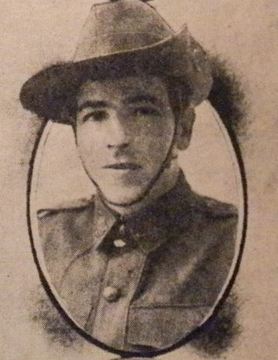
27884
DAVIES, Henry Durham
| Service Number: | 1150 |
|---|---|
| Enlisted: | 18 September 1914 |
| Last Rank: | Sergeant |
| Last Unit: | 48th Infantry Battalion |
| Born: | Glenelg, South Australia, Australia, 7 October 1889 |
| Home Town: | Streaky Bay, Streaky Bay, South Australia |
| Schooling: | Not yet discovered |
| Occupation: | Labourer |
| Died: | 1966, cause of death not yet discovered, place of death not yet discovered |
| Cemetery: |
Streaky Bay Cemetery, S.A. |
| Memorials: |
World War 1 Service
| 18 Sep 1914: | Enlisted AIF WW1, Private, 1150, 16th Infantry Battalion (WW1) | |
|---|---|---|
| 22 Dec 1914: | Involvement Private, 1150, 16th Infantry Battalion (WW1), --- :embarkation_roll: roll_number: '12' embarkation_place: Melbourne embarkation_ship: HMAT Ceramic embarkation_ship_number: A40 public_note: '' | |
| 22 Dec 1914: | Embarked Private, 1150, 16th Infantry Battalion (WW1), HMAT Ceramic, Melbourne | |
| 11 Nov 1918: | Involvement Sergeant, 1150, 48th Infantry Battalion | |
| Date unknown: | Honoured Distinguished Conduct Medal | |
| Date unknown: | Wounded 1150, 40th Infantry Battalion | |
| Date unknown: | Wounded 1150, 48th Infantry Battalion |
Help us honour Henry Durham Davies's service by contributing information, stories, and images so that they can be preserved for future generations.
Add my storyBiography contributed by Stephen Brooks
Harry Durham Davies served at the Landing on Gallipoli with the 16th Battalion. During May 1915 he was promoted to Lance Corporal then Corporal. He was wounded in action on the 29 May 1915, gunshot wounds to the thigh and buttock, and was evacuated to Malta. He returned to Anzac during July 1915 and was promoted to Sergeant on the 6 September 1915. He was again wounded in the hip by shrapnel on the 25 September 1915. He was evacuated to Egypt. He was mentioned for gallantry in Ian Hamilton’s despatch dated 5 November 1915 and awarded an MID for Gallipoli which is quite rare. He again joined the 16th Battalion at Gallipoli during late October 1915 and stuck it out until the evacuation.
During the reorganisation of the AIF in early 1916 he was transferred from the 16th Battalion to its daughter battalion the 48th. He was very badly knocked about at Pozieres on the 8 August 1916, and was evacuated to England with bullet and shrapnel wounds to the right arm, head, right leg and chest. He did not re-join the 48th Battalion until the 3 May 1917, just in time for Bullecourt. He was again wounded in Belgium on the 29 September 1917, by shrapnel in the chest, but was back with his unit in early November 1917.
He was awarded a Distinguished Conduct Medal for his actions at Villers Bretonneux on the 3 May 1918 when he was Sergeant of a mopping up party. He was badly wounded in both thighs but refused to retire and singlehandedly took six enemy prisoners. He was ordered back to the dressing station and took his prisoners with him. Before he got his wounds dressed, he gave his superiors much valuable information on the current situation at the front line.
This was the fifth time he had been wounded and he was sent back to England in June 1918. He was returned to Australia on special 1914 leave during October 1918.











